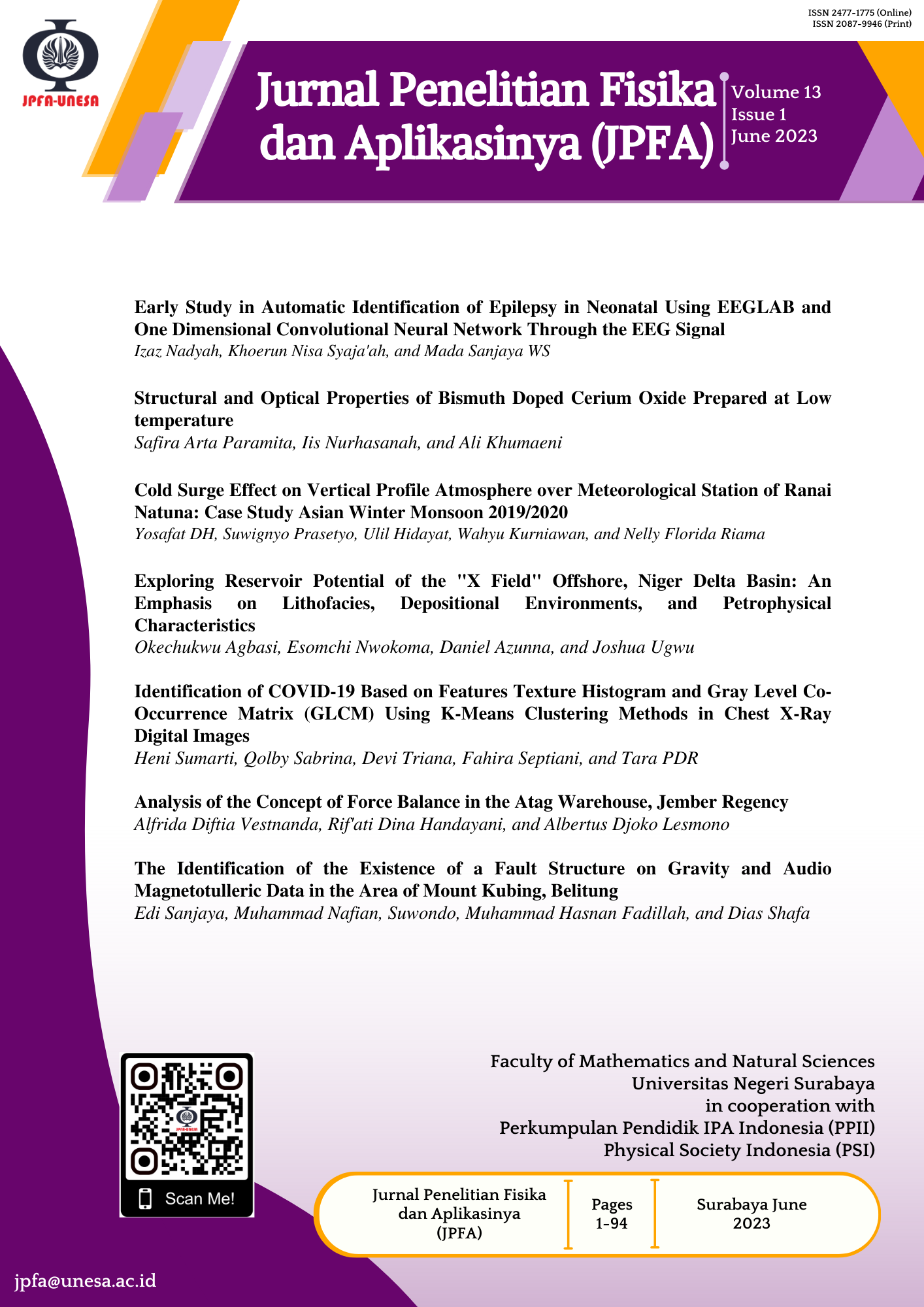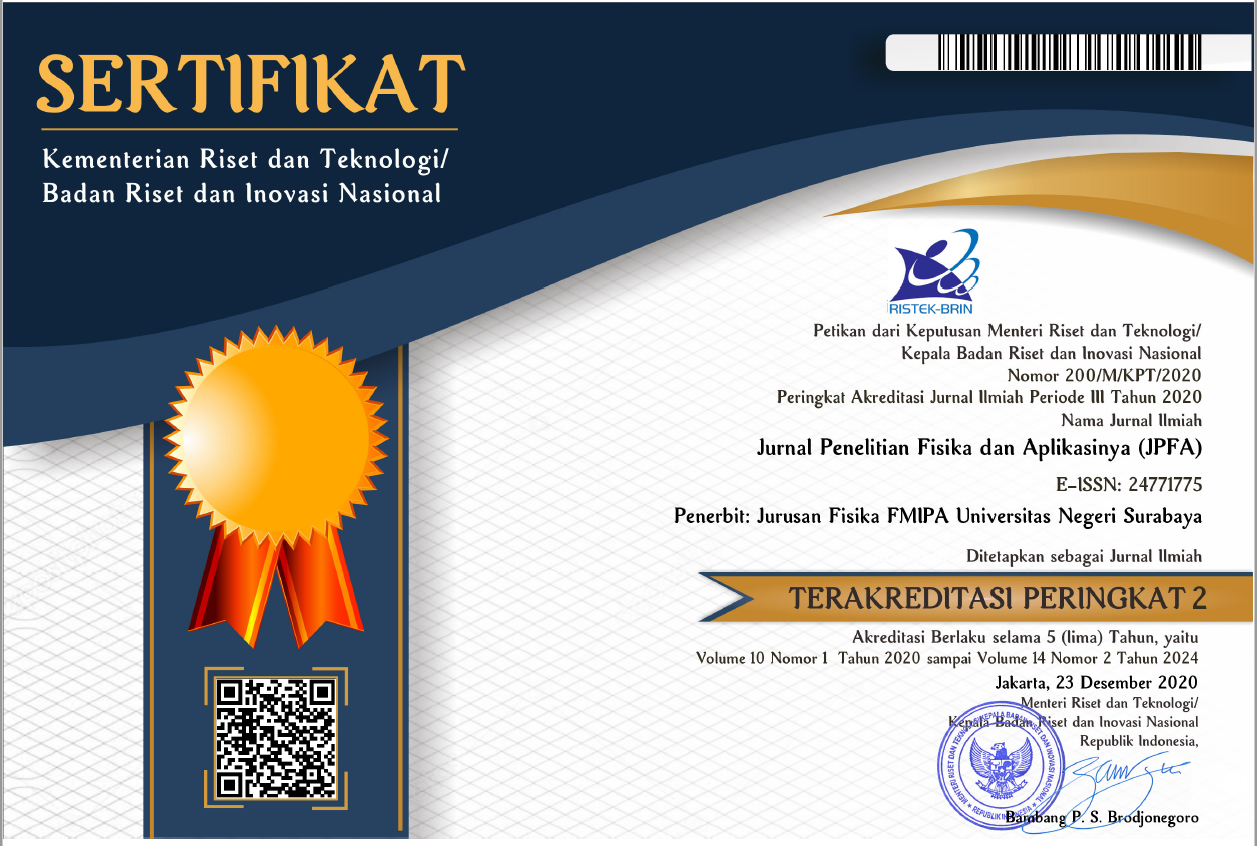Cold Surge Effect on Vertical Profile Atmosphere over Meteorological Station of Ranai Natuna: Case Study Asian Winter Monsoon 2019/2020
DOI:
https://doi.org/10.26740/jpfa.v13n1.p25-37Keywords:
cold surge, physical atmosphere, kinematic atmosphere, thermodynamic atmosphereAbstract
During the Asian Winter season, which spans from November to February, the phenomenon of cold surge often occurs, leading to increased convective activity over the western Indonesian Maritime Continent. The location of Natuna Island, situated in the southern part of the South China Sea, is of particular importance for studying cold surges due to their propagation over this area. In this study, the vertical structure of the atmosphere was analyzed using radiosonde observation data collected at the Meteorological Station of Ranai Natuna. The analysis focused on physical parameters such as air temperature and relative humidity, atmospheric kinematics including wind direction and speed, as well as atmospheric thermodynamic parameters such as Lifting Condensation Level (LCL), Level of Free Convection (LFC), Equilibrium Level (EL), Convective Available Potential Energy (CAPE), and Convective Inhibition (CIN). The results indicate that during the passage of a cold surge, air temperature (T) tends to be higher in the lower troposphere, including at the surface, but lower in the middle and upper troposphere. Relative humidity (RH) also tends to be higher during cold surges, with a significant increase in the middle and upper troposphere. In the lower troposphere, the wind direction shifts from east to northeast at a higher speed compared to when a cold surge is absent. Furthermore, the LCL and LFC heights are elevated during the presence of a cold surge, while the EL height shows an insignificant decrease. It is worth noting that intense rainfall occurs, particularly when the cold surge is more pronounced, even though the values of CAPE and CIN do not change significantly.
References
Chang C-P, Lu M-M, and Lim H. Monsoon Convection in the Maritime Continent: Interaction of Large-Scale Motion and Complex Terrain. Meteorological Monographs. 2016; 56: 6.1-6.29. DOI: https://doi.org/10.1175/amsmonographs-d-15-0011.1.
Tan I, et al. Wet and Dry Cold Surges Over the Maritime Continent. ESS Open Archive. 2022; preprint. DOI: https://doi.org/10.1002/essoar.10512941.1.
Tangang FT, et al. On the Roles of the Northeast Cold Surge, the Borneo Vortex, the Madden-Julian Oscillation, and the Indian Ocean Dipole During the Extreme 2006/2007 Flood in Southern Peninsular Malaysia. Geophysical Research Letters. 2008; 35(14): L14S07. DOI: https://doi.org/10.1029/2008GL033429.
Yoneyama K and Zhang C. Years of the Maritime Continent. Geophysical Research Letters. 2020; 47(12): e2020GL087182. DOI: https://doi.org/10.1029/2020GL087182.
Makmur E, et al. Characteristics of 7 Northerly Cold Surge Events During Years of the Maritime Continent Campaign 2021. EGU General Assembly 2022. 2002; EGU22-2111. DOI: https://doi.org/10.5194/egusphere-egu22-2111.
Wirjohamidjojo S and Swarinoto Y. Synoptic Meteorology (Analysis and Assessment of Synoptic Weather Analysis Results). Center for Research and Development, BMKG; 2013.
Makmur E, et al. An Overview of Cold Surge Observation During 2021 Years of the Maritime Continent Campaign. AGU Fall Meeting Abstract. 2021: pp. A53C-03. Available from: https://ui.adsabs.harvard.edu/abs/2021AGUFM.A53C..03M/abstract
Ramage CS. Monsoon Meteorology. New York: Academic Press; 1971.
Downloads
Published
How to Cite
Issue
Section
License
Copyright (c) 2023 Jurnal Penelitian Fisika dan Aplikasinya (JPFA)

This work is licensed under a Creative Commons Attribution-NonCommercial 4.0 International License.
Author(s) who wish to publish with this journal should agree to the following terms:
- Author(s) retain copyright and grant the journal right of first publication with the work simultaneously licensed under a Creative Commons Attribution-Non Commercial 4.0 License (CC BY-NC) that allows others to share the work with an acknowledgement of the work's authorship and initial publication in this journal for noncommercial purposes.
- Author(s) are able to enter into separate, additional contractual arrangements for the non-exclusive distribution of the journal's published version of the work (e.g., post it to an institutional repository or publish it in a book), with an acknowledgement of its initial publication in this journal.
The publisher publish and distribute the Article with the copyright notice to the JPFA with the article license CC-BY-NC 4.0.
 Abstract views: 633
,
Abstract views: 633
, PDF Downloads: 577
PDF Downloads: 577









